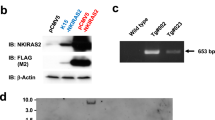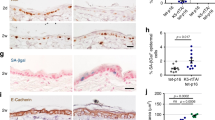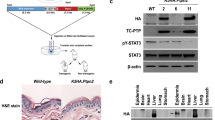Abstract
The E2F1 transcription factor, which is deregulated in most human cancers by mutations in the p16-cyclin D-Rb pathway, has both oncogenic and tumor-suppressive properties. This is dramatically illustrated by the phenotype of an E2F1 transgenic mouse model that spontaneously develops tumors in the skin and other epithelial tissues but is resistant to papilloma formation when subjected to a two-stage carcinogenesis protocol. Here, this E2F1 transgenic model was used to further explore the tumor-suppressive property of E2F1. Transgenic expression of E2F1 was found to inhibit ras-driven skin carcinogenesis at the promotion stage independent of the type of promoting agent used. E2F1 transgenic epidermis displayed increased expression of p19ARF, p53, and p21Cip1. Inactivation of either p53 or Arf in E2F1 transgenic mice restored sensitivity to two-stage skin carcinogenesis. While Arf inactivation impaired tumor suppression and p21 induction by E2F1, it did not reduce the level of apoptosis observed in E2F1 transgenic mice. Based on these findings, we propose that E2F1 suppresses ras-driven skin carcinogenesis through a nonapoptotic mechanism involving ARF and p53.
This is a preview of subscription content, access via your institution
Access options
Subscribe to this journal
Receive 50 print issues and online access
$259.00 per year
only $5.18 per issue
Buy this article
- Purchase on Springer Link
- Instant access to full article PDF
Prices may be subject to local taxes which are calculated during checkout






Similar content being viewed by others
References
Barak Y, Juven T, Haffner R, Oren M . (1993). EMBO J 12: 461–468.
Bates S, Phillips AC, Clark PA, Stott F, Peters G, Ludwig RL et al. (1998). Nature 395: 124–125.
Blattner C, Sparks A, Lane D . (1999). Mol Cell Biol 19: 3704–3713.
Conner EA, Lemmer ER, Omori M, Wirth PJ, Factor VM, Thorgeirsson SS . (2000). Oncogene 19: 5054–5062.
Conti CJ . (1994) In: Sundberg JP (ed). Handbook of Mouse Mutations with Skin and Hair Abnormalities. Boca Raton, FL: CRC, pp 39–46.
de Stanchina E, McCurrach ME, Zindy F, Shieh SY, Ferbeyre G, Samuelson AV et al. (1998). Genes Dev 12: 2434–2442.
DeGregori J, Leone G, Miron A, Jakoi L, Nevins JR . (1997). Proc Natl Acad Sci USA 94: 7245–7250.
Denchi EL, Attwooll C, Pasini D, Helin K . (2005). Mol Cell Biol 25: 2660–2672.
Dimri GP, Itahana K, Acosta M, Campisi J . (2000). Mol Cell Biol 20: 273–285.
Donehower LA, Harvey M, Slagle BL, McArthur MJ, Montgomery Jr CA, Butel JS et al. (1992). Nature 356: 215–221.
Eymin B, Karayan L, Seite P, Brambilla C, Brambilla E, Larsen CJ et al. (2001). Oncogene 20: 1033–1041.
Fischer SM, O'Connell JF, Conti CJ, Tacker KC, Fries JW, Patrick KE et al. (1987). Carcinogenesis 8: 421–424.
Gorgoulis VG, Zacharatos P, Mariatos G, Kotsinas A, Bouda M, Kletsas D et al. (2002). J Pathol 198: 142–156.
Greenhalgh DA, Wang XJ, Donehower LA, Roop DR . (1996). Cancer Res 56: 4413–4423.
Irwin M, Marin MC, Phillips AC, Seelan RS, Smith DI, Liu W et al. (2000). Nature 407: 645–648.
Johnson DG, Cress WD, Jakoi L, Nevins JR . (1994a). Proc Natl Acad Sci USA 91: 12823–12827.
Johnson DG, Ohtani K, Nevins JR . (1994b). Genes Dev 8: 1514–1525.
Johnson DG, Schwarz JK, Cress WD, Nevins JR . (1993). Nature 365: 349–352.
Kamijo T, Zindy F, Roussel MF, Quelle DE, Downing JR, Ashmun RA et al. (1997). Cell 91: 649–659.
Kemp CJ, Donehower LA, Bradley A, Balmain A . (1993). Cell 74: 813–822.
Khan SH, Moritsugu J, Wahl GM . (2000). Proc Natl Acad Sci USA 97: 3266–3271.
Kowalik TF, DeGregori J, Schwarz JK, Nevins JR . (1995). J Virol 69: 2491–2500.
Leder A, Kuo A, Cardiff RD, Sinn E, Leder P . (1990). Proc Natl Acad Sci USA 87: 9178–9182.
Lin AW, Barradas M, Stone JC, van Aelst L, Serrano M, Lowe SW . (1998). Genes Dev 12: 3008–3019.
Lin AW, Lowe SW . (2001). Proc Natl Acad Sci USA 98: 5025–5030.
Lin WC, Lin FT, Nevins JR . (2001). Genes Dev 15: 1833–1844.
Martelli F, Hamilton T, Silver DP, Sharpless NE, Bardeesy N, Rokas M et al. (2001). Proc Natl Acad Sci USA 98: 4455–4460.
Missero C, Di Cunto F, Kiyokawa H, Koff A, Dotto GP . (1996). Genes Dev 10: 3065–3075.
Mitchell DL, Greinert R, de Gruijl FR, Guikers KL, Breitbart EW, Byrom M et al. (1999). Cancer Res 59: 2875–2884.
Moroni MC, Hickman ES, Denchi EL, Caprara G, Colli E, Cecconi F et al. (2001). Nat Cell Biol 3: 552–558.
Nahle Z, Polakoff J, Davuluri RV, McCurrach ME, Jacobson MD, Narita M et al. (2002). Nat Cell Biol 4: 859–864.
Palmero I, Pantoja C, Serrano M . (1998). Nature 395: 125–126.
Pan H, Yin C, Dyson NJ, Harlow E, Yamasaki L, Dyke TV . (1998). Mol Cell Biol 2: 283–292.
Paramio JM, Segrelles C, Ruiz S, Martin-Caballero J, Page A, Martinez J et al. (2001). J Biol Chem 276: 44203–44211.
Pierce AM, Fischer SM, Conti CJ, Johnson DG . (1998a). Oncogene 16: 1267–1276.
Pierce AM, Gimenez-Conti IB, Schneider-Broussard R, Martinez LA, Conti CJ, Johnson DG . (1998b). Proc Natl Acad Sci USA 95: 8858–8863.
Pierce AM, Schneider-Broussard R, Gimenez-Conti IB, Russell JL, Conti CJ, Johnson DJ . (1999). Mol Cell Biol 19: 6408–6414.
Powers JT, Hong S, Mayhew CN, Rogers PM, Knudsen ES, Johnson DG . (2004). Mol Cancer Res 2: 203–214.
Prives C . (1998). Cell 95: 5–8.
Qin X-Q, Livingston Jr WGK, Adams PD . (1994). Proc Natl Acad Sci USA 91: 10918–10922.
Quintanilla M, Brown K, Ramsden M, Balmain A . (1986). Nature 322: 78–80.
Ramirez A, Bravo A, Jorcano JL, Vida M . (1994). Differentiation 58: 53–64.
Rizos H, Woodruff S, Kefford RF . (2005). Cell Cycle 4: 597–603.
Rogoff HA, Pickering MT, Debatis ME, Jones S, Kowalik TF . (2002). Mol Cell Biol 22: 5308–5318.
Rogoff HA, Pickering MT, Frame FM, Debatis ME, Sanchez Y, Jones S et al. (2004). Mol Cell Biol 24: 2968–2977.
Rounbehler RJ, Rogers PM, Conti CJ, Johnson DG . (2002). Cancer Res 62: 3276–3281.
Rounbehler RJ, Schneider-Broussard R, Conti CJ, Johnson DG . (2001). Oncogene 20: 5341–5349.
Russell JL, Powers JT, Rounbehler RJ, Rogers PM, Conti CJ, Johnson DG . (2002). Mol Cell Biol 22: 1360–1368.
Saito M, Helin K, Valentine MB, Griffith BB, Willman CL, Harlow E et al. (1995). Genomics 25: 130–138.
Serrano M, Lin AW, McCurrach ME, Beach D, Lowe SW . (1997). Cell 88: 593–602.
Sherr CJ . (2000). Cancer Res 60: 3689–3695.
Suganuma M, Fujiki H, Suguri H, Yoshizawa S, Hirota M, Nakayasu M et al. (1988). Proc Natl Acad Sci USA 85: 1768–1771.
Tolbert D, Lu X, Yin C, Tantama M, Van Dyke T . (2002). Mol Cell Biol 22: 370–377.
Tsai KY, Hu Y, Macleod KF, Crowley D, Yamasaki L, Jacks T . (1998). Mol Cell 2: 293–304.
Tsai KY, MacPherson D, Rubinson DA, Crowley D, Jacks T . (2002). Curr Biol 12: 159–163.
Vorburger SA, Pataer A, Yoshida K, Barber GN, Xia W, Chiao P et al. (2002). Oncogene 21: 6278–6288.
Wang D, Russell J, Xu H, Johnson DG . (2001). Mol Carcinog 31: 90–100.
Wang D, Russell JL, Johnson DG . (2000). Mol Cell Biol 20: 3417–3424.
Wei W, Hemmer RM, Sedivy JM . (2001). Mol Cell Biol 21: 6748–6757.
Wu X, Bayle JH, Olson D, Levine AJ . (1993). Genes Dev 7: 1126–1132.
Wu X, Levine AJ . (1994). Proc Natl Acad Sci USA 91: 3602–3606.
Xu G, Livingston DM, Krek W . (1995). Proc Natl Acad Sci USA 92: 1357–1361.
Yamasaki L, Jacks T, Bronson R, Goillot E, Harlow E, Dyson NJ . (1996). Cell 85: 537–548.
Yuspa SH . (1998). J Dermatol Sci 17: 1–7.
Zhu JW, Field SJ, Gore L, Thompson M, Yang H, Fujiwara Y et al. (2001). Mol Cell Biol 21: 8547–8564.
Ziegler A, Jonason AS, Leffell DJ, Simon JA, Sharma HW, Kimmelman J et al. (1994). Nature 372: 773–776.
Zindy F, Eischen CM, Randle DH, Kamijo T, Cleveland JL, Sherr CJ et al. (1998). Genes Dev 12: 2424–2433.
Acknowledgements
We thank Jen Smith and Nancy Abbey for outstanding technical assistance; Dale Weiss, Lezlee Coghlan and co-workers for animal care; Irma Gimenez-Conti and co-workers for histology; Chris Brown and Joi Holcomb for artwork; Howard Thames for statistical analysis; and Shawnda Sanders for preparation of the manuscript. We also thank James DeGregori and Andriy Marusyk for helpful comments. This work was supported by grants from the National Institute of Health (CA79648 to DGJ, NIEHS center Grant ESO7784, and CA16672). JLR was supported in part by an American Legion Auxiliary Fellowship and training grant CA09480. TRB was supported by a Minority Postdoctoral Supplement from the Comprehensive Minority Biomedical Branch, NIH.
Author information
Authors and Affiliations
Corresponding author
Rights and permissions
About this article
Cite this article
Russell, J., Weaks, R., Berton, T. et al. E2F1 suppresses skin carcinogenesis via the ARF-p53 pathway. Oncogene 25, 867–876 (2006). https://doi.org/10.1038/sj.onc.1209120
Received:
Revised:
Accepted:
Published:
Issue Date:
DOI: https://doi.org/10.1038/sj.onc.1209120



